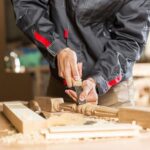Are you wondering how to mount woodworking vise for your next DIY project? A woodworking vise is an essential tool that provides stability and support while working on wood projects. Whether you are a beginner or a seasoned woodworker, understanding the role of a woodworking vise is crucial for achieving precise and accurate results in your woodworking endeavors.
In this article, we will explore the different types of woodworking vises, compare their functionalities, and discuss the factors to consider when choosing the right location for mounting. We will provide a comprehensive checklist of tools and materials needed for mounting a woodworking vise and offer detailed instructions for a secure installation. Additionally, we’ll share tips for proper maintenance and care, as well as common mistakes to avoid when mounting a woodworking vise.
By the end of this article, you will have a thorough understanding of the importance of a woodworking vise in your workshop, as well as the knowledge and confidence to mount one effectively for your woodworking projects. Whether you are looking to upgrade your current setup or are considering purchasing your first woodworking vise, this guide will help you make informed decisions and achieve optimal functionality in your woodshop.
Types of Woodworking Vises
When it comes to mounting a woodworking vise, it is essential to consider the type of vise you are working with. There are three main types of woodworking vises: bench vises, shoulder vises, and leg vises. Each type has its own unique features and functions, so it’s important to understand the differences in order to choose the right one for your specific needs.
Bench vises are the most common type of woodworking vise and are typically mounted underneath a workbench. They are versatile and can be used for a wide range of woodworking tasks, making them a popular choice for many woodworkers.
Shoulder vises, on the other hand, are designed specifically for holding the edges of boards while working on the face or ends. They are usually mounted on the front or side of a workbench and provide excellent support for various woodworking projects.
Leg vises, also known as “face” or “twin screw” vises, are another popular option for woodworkers. Unlike bench and shoulder vises, which are mounted underneath or alongside a workbench, leg vises are attached to one of the legs of the workbench itself. This design allows for increased stability and clamping power, making leg vises ideal for heavy-duty woodworking tasks.
It’s important to carefully consider your specific woodworking needs when choosing the right type of vise for your workshop. Understanding the unique features and functions of bench vises, shoulder vises, and leg vises will help you make an informed decision about how to mount woodworking vise that best suits your individual requirements.
| Woodworking Vise Type | Mounting Location |
|---|---|
| Bench Vise | Underneath Workbench |
| Shoulder Vise | Front or Side of Workbench |
| Leg Vise | Attached to Workbench Leg |
Choosing the Right Location for Mounting
When it comes to mounting a woodworking vise, choosing the right location is crucial for ensuring optimal functionality and convenience. There are several factors to consider when selecting the ideal spot for your vise, including the type of work you’ll be doing, the size of your workbench, and your preferred working height. By taking these considerations into account, you can maximize the efficiency and usability of your woodworking vise.
Workbench Layout and Space
Before mounting your woodworking vise, take a close look at your workbench layout and available space. Consider the dimensions of your bench and where there is sufficient room to accommodate the vise without obstructing other tools or work areas. It’s also essential to assess whether the area you’ve chosen will provide enough clearance for long pieces of wood or large projects that may require additional support.
Work Height and Ergonomics
Another vital factor to consider when choosing a location for mounting your woodworking vise is work height and ergonomics. Determine a comfortable working height that allows you to apply adequate pressure when using the vise without straining or bending awkwardly. Keep in mind that different tasks may require varying levels of force, so it’s beneficial to have some flexibility in adjusting the vise’s position if needed.
Accessibility and Lighting
Lastly, think about accessibility and lighting in the chosen location. Ensure that the mounted vise is easily accessible from all sides of the workbench, especially if you frequently rotate or reposition your projects during woodworking tasks. Additionally, consider natural or artificial lighting sources in the area to optimize visibility while working with your vise-mounted projects. By carefully evaluating these factors, you can select a mounting location that enhances both functionality and comfort when using your woodworking vise effectively.
Tools and Materials You’ll Need for Mounting a Woodworking Vise
Mounting a woodworking vise requires the right tools and materials to ensure a secure and stable installation. Without the proper equipment, you may encounter difficulties in mounting the vise, which can lead to safety hazards and subpar functionality. In this section, we will provide a comprehensive checklist of the essential tools and materials you’ll need for mounting a woodworking vise.
Essential Tools
To mount a woodworking vise, you will need several essential tools such as a drill, screwdriver, wrench, level, measuring tape, pencil, and safety goggles. The drill should be capable of drilling into various materials including wood and metal. A screwdriver with interchangeable bits is recommended for tightening screws of different sizes.
A wrench will be essential for securing bolts and nuts during the mounting process. Using a level is crucial to ensure that the vise is mounted perfectly straight, while a measuring tape and pencil will help mark the precise locations for drilling.
Required Materials
In addition to the necessary tools, you’ll also need specific materials to successfully mount your woodworking vise. These materials include wood screws or lag bolts (depending on the type of workbench), washers, wood glue (if needed), and a mounting template.
It’s important to select high-quality wood screws or lag bolts that are strong enough to support the weight and pressure exerted on the vise during use. Furthermore, using washers can help distribute pressure evenly across the surface of the workbench.
Safety Gear
Lastly, don’t forget about personal protective equipment such as safety goggles when working with power tools. When drilling into hard materials like metal or hardwoods, there’s always a risk of flying debris which could potentially cause injuries to your eyes if not properly protected.
By ensuring that you have all the necessary tools, materials, and safety gear before starting the mounting process, you can minimize complications and achieve a secure installation for your woodworking vise.
Now that we’ve covered everything you’ll need for mounting your woodworking vise let’s move on to our next section: Step-by-Step Guide to Mounting a Woodworking Vise: Detailed Instructions for Secure Installation.
Step-by-Step Guide to Mounting a Woodworking Vise
Mounting a woodworking vise is an important step in setting up your woodworking space, as it allows you to securely hold your workpieces in place while you work on them. Whether you are a beginner or a seasoned woodworker, knowing how to mount a woodworking vise properly is crucial for ensuring its optimal functionality and longevity.
To mount a woodworking vise, you will need the following tools and materials:
Tools:
Materials:
Once you have gathered all the necessary tools and materials, follow these step-by-step instructions for mounting your woodworking vise:
1. Choose the location: Decide where you want to mount the vise on your workbench. Consider factors such as the height and accessibility of the vise, as well as the proximity to other tools and work areas.
2. Prepare the workbench: If your workbench is made of wood, consider reinforcing it with additional wood blocks underneath where the vise will be mounted for added stability.
3. Mark and drill holes: Place the vise in position on the workbench and use a pencil to mark where the screw holes will be drilled. Use a drill to create pilot holes for the screws.
4. Attach the vise: Line up the vise with the pilot holes and use wood screws and washers to secure it in place. Use a level to ensure that the vise is mounted evenly and securely.
Following these steps will ensure that your woodworking vise is securely mounted and ready for use in your woodworking projects. Proper installation is essential for ensuring that your vise functions effectively and safely during use.
Tips and Tricks for Proper Maintenance and Care of a Mounted Woodworking Vise
A woodworking vise is an essential tool for any woodworker, allowing for a secure grip on your workpiece while you saw, chisel, or plane. Proper maintenance and care of your mounted woodworking vise are crucial to ensuring its longevity and optimal functionality. Here are some tips and tricks for keeping your woodworking vise in top condition:
1. Regular Cleaning: It’s important to keep your woodworking vise clean to prevent dust and debris from affecting its performance. Use a brush or compressed air to remove any buildup of sawdust, wood shavings, or other materials from the vise’s mechanism.
2. Lubrication: Periodically lubricating the moving parts of your mounted woodworking vise will help ensure smooth operation. Use a light machine oil or silicone spray lubricant to grease the screws, threads, and pivots of the vise.
3. Avoid Over-tightening: While it may be tempting to really crank down on your woodworking vise to secure your workpiece, over-tightening can put unnecessary strain on the mechanism and lead to premature wear and tear. Use just enough pressure to hold your workpiece securely without straining the vise.
4. Protecting the Jaws: The jaws of your woodworking vise can become damaged over time from gripping rough or irregularly shaped workpieces. Consider installing protective jaw covers or using sacrificial scraps of wood between the workpiece and jaws to prevent damage.
5. Inspection and Adjustment: Regularly inspect the mounting hardware and alignment of your woodworking vise. Check for any loose bolts or screws, misalignment, or irregularities in movement that could indicate a need for adjustment or repair.
By following these tips for proper maintenance and care of a mounted woodworking vise, you can ensure that it continues to serve as a reliable tool in your workshop for years to come.
Common Mistakes to Avoid When Mounting a Woodworking Vise
Mounting a woodworking vise is a crucial step in setting up your woodworking workspace, and it’s important to avoid common mistakes to ensure its proper functionality. In this section, we will discuss some lessons learned from experience to help you navigate the process of mounting a woodworking vise without encountering unnecessary setbacks.
One common mistake when mounting a woodworking vise is not taking into account the thickness and strength of the workbench or table where the vise will be installed. It’s essential to ensure that the mounting location can support the weight and pressure exerted on the vise during use. Failing to do so can result in instability and potential damage to your work surface.
Another mistake to avoid is overlooking the importance of properly aligning the vise with the edge of the workbench. The alignment significantly impacts the vise’s functionality and ease of use. Carefully measuring and marking the position for mounting can prevent misalignment, ensuring that your woodworking projects are held securely in place.
Finally, it’s important not to rush through the mounting process. Taking the time to carefully follow instructions, double-check measurements, and use quality tools and hardware will contribute to a successful and durable installation. Rushing through the process increases the likelihood of errors that could compromise the effectiveness of your woodworking vise.
| Common Mistakes When Mounting Woodworking Vise | Lessons Learned From Experience |
|---|---|
| Not considering workbench strength | Ensure adequate support for vise weight and pressure |
| Overlooking proper alignment | Take time to measure and mark mounting position accurately |
| Rushing through installation | Patience and attention to detail are key for successful mounting |
Advanced Mounting Techniques and Upgrades for Enhancing the Performance of Your Woodworking Vise
In conclusion, mounting a woodworking vise is an essential skill for any woodworker, and it can significantly enhance the functionality of your workbench. Understanding the role of a woodworking vise and the different types available is crucial in choosing the right one for your specific needs. Once you have selected the appropriate vise, it is important to carefully consider the location for mounting, as this will directly impact its usability and efficiency.
When it comes to actually mounting the woodworking vise, having the right tools and materials is key to ensuring a secure installation. Following a step-by-step guide will help you navigate the process with ease and confidence. Additionally, proper maintenance and care are vital for prolonging the life of your mounted woodworking vise and maximizing its performance.
Finally, considering advanced mounting techniques and upgrades can take your woodworking vise to the next level. Whether it’s adding accessories or implementing innovative mounting methods, these enhancements can further enhance the functionality of your vise. By paying attention to these important details throughout each step of the process, you’ll be well-equipped to mount your woodworking vise effectively and enjoy its benefits for years to come.

Hi everyone! I’m a woodworker and blogger, and this is my woodworking blog. In my blog, I share tips and tricks for woodworkers of all skill levels, as well as project ideas that you can try yourself.





